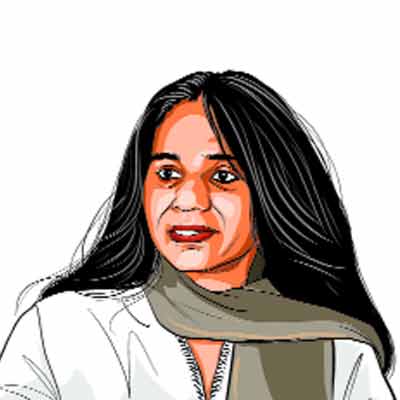Opinion Our own lost generation
With Tyeb Mehta and M.F. Husain,Biren De and Jehangir Sabavala,a time has conclusively passed.
As those magnificent men pass away,one by one,there is a sense of nostalgia and of longing for the time spent in their company. It seems that those moments of mulling over art,of ruminating on their work and watching dexterous movements with the paintbrush will never come back.
When Tyeb Mehta passed away in July 2009,I felt the deep loss of an artist who had spent countless hours explaining the intricacies of his work in his flat-cum-studio in suburban Mumbai. We would be surrounded by books on art,a powerful bull head sculpted by him looking down at us,as he spoke about how his paintings were taking shape. In later years,despite his poor peripheral vision and other health difficulties,he would walk to the adjoining studio and meticulously pick up his brush to paint. As a stark,room-sized black-and-white bull diptych came into existence,occupying the entire wall,one could feel his work was beginning to take new directions unfortunately,cut short by his death.
Another chapter closed when Biren De died in March this year. My memory of him is tinged with sadness as he sat,very solitary in his Delhi flat (he alternated his time here with Germany,where his wife lived),and spoke of the past. It was amazing to see how fresh and alive it was for him,as he reminisced about his move from Kolkata to Delhi as a young man and his spiralling towards fame entirely on his own. His family had broken off with him for taking to art,and he was entirely alone except for his wife; and when he was not well he often regretted the lack of support from the artist community.
The Copenhagen-based Sohan Qadri too passed away in March and although I didnt know him personally,one was captivated by his ephemeral vision,which created those luminous,dye-infused and finely textured paintings.
When M.F. Husain left us in June,one could sense that an era had ended. A painful death away from home,in London; but I am told that he remained optimistic and buoyant till the end,talking of having a Chinese meal with his friends. How well I remember meeting him in New York in September 2009. It was a day after he had turned 94; he contended that,as after turning 90 he began counting from his birth again,he had just turned four! Barefoot,he had come to the New York gallery to complete a room-sized mural that narrated the journey of his life. Perched on the high mechanical device which moved along the wall to enable him to paint,his brush moved with great agility and we marvelled at the tautness of the forms,which didnt loose their firm grip on events. A panoramic life,a seamless unfolding of events,was unrolling before our eyes! His hand remained as skilled till the end,and we saw at Pundole gallery in
Mumbai earlier this year a print of the Ramayana which he had just finished painting and had sent for his friend and fellow artist,Bal Chhabda,who is ailing and unable to travel.
Perhaps the most poignant is the passing away of Jehangir Sabavala in Mumbai earlier this month. He was the perfect gentleman,speaking to high and low alike,and engaging with life to the hilt. I remember when as a young initiate,I would come across Jehangir at exhibition openings and he would speak to me at length,explaining the innards of art and pointing out the various intricacies of a painting. When I curated the large show of the Progressive Artists which inaugurated the National Gallery of Modern Art in Mumbai in 1996,there was fierce opposition from all the artists who were not included. Jehangir,a descendent of the same family that owned the mansion now housing the Jehangir Art Gallery,and who was one of the trustees of the museum,was the one who provided support though he was not included. This despite the fact that the Progressive artists had been quite dismissive of him.
A few years ago when he had come to receive the National Award from the Lalit Kala Akademi,he spoke to me length about his life. He had trained in Paris under Andre Lhote but chosen to return home because he felt a rootedness and an attachment to his home country. Sitting at the India International Centre in Delhi,where he was staying,he waved his hand when asked if he regretted it. None of this mattered to him except his art,which was a solitary exercise and when struggling with it,you were alone.
He said,As a painter all those hours spent alone you are not only thinking of the painting. You are thinking of yourself,of death,of mortality,of tragedies and happiness. Not so very consciously of death,not at all,but in the working day… I distinctly remember thinking of all this whilst at the same time keeping a concentration on what you are trying to say on the canvas which is not necessarily at all related to the thoughts passing through your head.
Yet Jehangir did regret the passing away of a cultural climate when artists met and talked about their work. According to him this was sadly missing in the present. To quote from this interview with him which featured in my recent book (Four Generations of Indian Artists in their Own Words,Oxford University Press,2011): What is lacking is the intellectual stimulation at the level of ideas,not the personalities and not this next exhibition thing. You know this gallery is doing that petty art politics. Rarely does one find a painter who sits down and has an exchange. Jehangir,whose presence was the very opposite,will be missed for the passion and grace he brought to the most trite occasion.
The writer is an art historian and independent curator based in New Delhi


